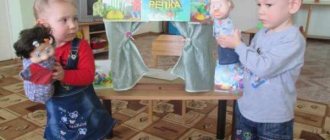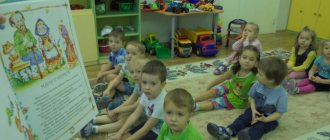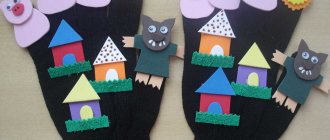The ability to communicate is inherent in man, and the need to develop and improve this ability is dictated by the very nature of man and his life in society. “Communication is one of the universal forms of personal activity (along with cognition, work, play), manifested in the establishment and development of contacts between people, in the formation of interpersonal relationships and generated by the needs for joint activities.”
In our age of extremely rapid technological progress, large-scale volumes of information, global computerization, the skill of simple communication, the ability to hear and listen to each other becomes especially relevant. The formation of this skill begins with the birth of a child and improves with growth and development.
It is no secret that modern parents call one of the prerequisites for placing their child in a preschool institution the opportunity to constantly be in a children's group, the opportunity to communicate with peers. The validity of this opinion is obvious. The need and importance of communication is also taken into account in the modern Federal State Educational Standard for Preschool Education. Thus, communicative development is part of one of the five educational areas, namely the area of “Socio-communicative development”. According to the Federal State Educational Standard for Additional Education, this educational area has a number of tasks:
Assimilation of norms and values accepted in society, including moral and moral values;
Development of communication and interaction of the child with adults and peers;
Formation of independence, purposefulness and self-regulation of one’s own actions;
Development of social and emotional intelligence, emotional responsiveness, empathy;
Formation of readiness for joint activities with peers;
Forming a respectful attitude and a sense of belonging to one’s family and to the community of children and adults;
Formation of positive attitudes towards various types of work and creativity;
Formation of the foundations of safe behavior in everyday life, society, and nature.
As we see, the importance of developing communication and the ability to interact with peers and adults is emphasized.
Solving problems in developing communication skills is solved in preschool educational institutions at different levels. First of all, in the process of continuous educational activities on speech development, cognitive development, in the interaction of the teacher with children, in individual work. An important element in the process of developing communication skills in preschool educational institutions is the organization of independent activities of children, where the key element is the developing subject-spatial environment. L.S. Vygotsky about (2. P.320). In the Federal State Educational Standard for Preschool Education, the subject-spatial developmental educational environment is declared as one of the aspects of the educational environment for a preschool child, and one of the functions of the subject-spatial developmental environment is defined as the communicative function.
To fulfill its tasks, the subject-spatial development environment must be meaningful, transformable, multifunctional, accessible and safe. In our opinion, one of the elements of such an environment that meets all the requirements is a theater corner, and one of the types of theater that especially contributes to the development and enrichment of communicative experience is the finger theater.
Theatrical activities have great educational and educational opportunities. By participating in theatrical activities, “children get acquainted with the world around them in all its diversity through images, colors, sounds, and skillfully posed questions force them to think, analyze, draw conclusions and generalizations. Improvement of speech is also closely related to mental development. In the process of working on the expressiveness of characters’ remarks and their own statements, the child’s vocabulary is imperceptibly activated, the sound culture of his speech and its intonation structure are improved. The role played and the spoken lines put the child in front of the need to express himself clearly, distinctly, and intelligibly. His dialogic speech and its grammatical structure improve.
It can be argued that theatrical activity is a source of development of feelings, deep experiences and discoveries of the child, and introduces him to spiritual values. This is a concrete, visible result. But it is equally important that theatrical activities develop the child’s emotional sphere, make him sympathize with the characters and empathize with the events being played out.” (3)
Various forms of organization are used in theatrical activities: joint theatrical activities of adults and children, theatrical activities, independent theatrical and artistic activities, theatrical games and performances at holidays, entertainment, and visits to theaters for children.
In general, theatrical activities can be divided into two large groups, dramatization play and “director’s” play. In dramatization games, the child plays a role as an “artist”
, independently creates an image using a set of means of verbal and non-verbal expressiveness.
In the director's game the “artists”
are the toys, and the child organizes the activity as a
“scriptwriter and director
,” manages
the “artists
,” but at the same time he himself is an
“artist
,” voicing the characters and commenting on the plot. If dramatization games make it possible to reveal a child’s artistic abilities and personal qualities to a greater extent, then director’s games in independent activities provide an excellent opportunity for communication and the development of communication skills. In our group, for independent director's theatrical games, we primarily offer finger theater.
The correct construction of sentences, the use of speech means and a variety of vocabulary are the goals that we strive for when developing the speech competence of preschoolers. However, nowadays, children at home often have experience with computer games, experience using interactive toys and games on mobile devices. As is known, such games and toys isolate the child, they do not teach him to communicate, but concentrate his consciousness on primitive, repetitive actions that do not bring either emotional, mental or speech development, but rather block the natural age-related development of speech. In this regard, the importance of developing the ability to communicate with each other in preschool educational institutions, the ability to build and conduct dialogue, both with peers and with adults, increases.
The finger theater provides an opportunity for children to develop imagination, thinking, and speech. When putting the dolls on your fingers, during manipulations, the development of fine motor skills naturally and effortlessly occurs, which, as has already been proven by researchers, is a necessary condition for the development of speech. In the process of acting out fairy tales or small play scenes, children learn to control their movements, train dexterity, concentration, accuracy and coordination of movements, and most importantly, learn to build a dialogue.
The finger theater in our group is part of a large theater corner. As a result, today it is represented by a collection of knitted toys based on the fairy tales “Teremok”, “Kolobok”, “The Three Little Pigs”, “The Three Bears”, “The Rock Hen”, “Turnip”, as well as knitted animal figurines. All characters are made by hand by T.M. Trefilova, the grandmother of a girl visiting our group. Purpose
The creation of this element of a subject-spatial developmental environment is the formation of communication and dialogue skills in preschoolers.
In this regard, the main tasks
we have identified are the formation of the ability to coherently and consistently express one’s thoughts, construct a detailed speech utterance and the formation of the ability to interact, negotiate, and build a joint dialogical game.
Work with the finger theater is carried out in two directions, which include different types of activities.
The first is the staging of fairy tales, nursery rhymes, riddles, and the performance of mini-skits on the topics of etiquette, friendship, and seasonal changes in nature. This happens during educational activities on speech development, the formation of basic mathematical skills, cognitive and artistic-aesthetic development, and routine moments. The teacher acts as a presenter and gives the children an example of simple exercises with dolls: bending over (greeting, saying hello), swaying from side to side (the character is angry, denying), characteristic movements. Special attention is paid to the speech of the characters and its intonation. Dolls are also used when working with orientation in space and the concepts of “right”, “left”, “top”, “bottom”, “in ...”, “on ...”, “behind ...”, “under ...”, etc. Separate attention is paid to the analysis of the characters' characters; problematic situations are created with the participation of dolls, which children willingly resolve and help the hero or ask him questions. At this stage we often use a screen.
For example, the children really like the game “Hide and Seek”, when we put several dolls on our fingers, the children close their eyes, one of the dolls is removed or swapped with another. The guys' task is to name the change.
The second stage is represented by children directly playing independently with finger theater puppets and takes place in their free time at the request of the children. Children choose their own form of play activity: sometimes they act out a familiar fairy tale. However, observations show that children often come up with small stories about heroes themselves, different plots, which sometimes reflect the events of the day and topics that concern them. It happens that two or three children take a set of dolls, and some join during the game and watch the “show.” It happens that one child takes the dolls and plays himself, placing them on the table. It is worth noting that at this stage children play without a screen, enjoying manipulating dolls and communicating with each other, building a dialogue.
Thus, finger theater as an element of a subject-spatial developmental environment is productive and occupies an important place in the organization of independent activities of preschool children. It performs communicative, cognitive, educational and developmental functions. Gives the teacher an opportunity to learn more about the child’s character, mood, and desires.
Helping children develop the ability to communicate and build dialogue, the “fairy tale on the palm” itself combines a certain dialogic nature, allowing not only self-expression and interaction in a team, but also to satisfy the child’s need for peace and solitude.
In the era of global technization and computerization, with a large assortment of children's toys of different options, knitted finger theater continues to be in demand by children, performs an important communicative function in the formation and development of a child’s personality, helps to learn interaction, joint activities, and also opens up the opportunity to listen to oneself, understand yourself, your movements and show your own discoveries to others.


